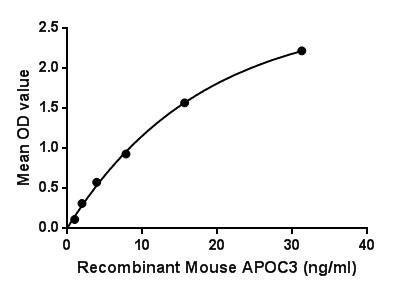Active Apolipoprotein C3 (APOC3)
Apo-C3; APOCIII; APOC-III
- Product No.APB890Mu01
- Organism SpeciesMus musculus (Mouse) Same name, Different species.
- Buffer Formulation20mM Tris, 150mM NaCl, pH8.0, containing 1mM EDTA, 1mM DTT, 0.01% SKL, 5% Trehalose and Proclin300.
- TraitsFreeze-dried powder
- Purity> 95%
- Isoelectric Point5.1
- ApplicationsCell culture; Activity Assays.
- Download Instruction Manual
- UOM 10µg50µg 200µg 1mg 5mg
-
FOB
US$ 324
For more details, please contact local distributors!US$ 810
For more details, please contact local distributors! US$ 1620
For more details, please contact local distributors! US$ 4860
For more details, please contact local distributors! US$ 12150
For more details, please contact local distributors!
ACTIVITY TEST of the Active Apolipoprotein C3 (APOC3)

Figure. The binding activity of APOC3 with PCYOX1.
Apolipoprotein C3 (APOC3) also known as apo-CIII is a component of very low density lipoprotein (VLDL). APOC3 inhibits lipoprotein lipase and hepatic lipase; it is thought to inhibit hepatic uptake of triglyceride-rich particles. An increase in apoC-III levels induces the development of hypertriglyceridemia. Some evidences suggest an intracellular role for Apo-CIII in promoting the assembly and secretion of triglyceride-rich VLDL particles from hepatic cells under lipid-rich conditions. Besides, Prenylcysteine Oxidase 1 (PCYOX1) has been identified as an interactor of APOC3, thus a binding ELISA assay was conducted to detect the interaction of recombinant mouse APOC3 and recombinant mouse PCYOX1. Briefly, APOC3 were diluted serially in PBS, with 0.01% BSA (pH 7.4). Duplicate samples of 100μL were then transferred to PCYOX1-coated microtiter wells and incubated for 2h at 37℃. Wells were washed with PBST and incubated for 1h with anti-APOC3 pAb, then aspirated and washed 3 times. After incubation with HRP labelled secondary antibody, wells were aspirated and washed 3 times. With the addition of substrate solution, wells were incubated 15-25 minutes at 37℃. Finally, add 50µL stop solution to the wells and read at 450nm immediately. The binding activity of APOC3 and PCYOX1 was shown in Figure 1, and this effect was in a dose dependent manner.
USAGE of the Active Apolipoprotein C3 (APOC3)
Reconstitute in 20mM Tris, 150mM NaCl (pH8.0) to a concentration of 0.1-1.0 mg/mL. Do not vortex.
STORAGE of the Active Apolipoprotein C3 (APOC3)
Avoid repeated freeze/thaw cycles. Store at 2-8°C for one month. Aliquot and store at -80°C for 12 months.
STABILITY of the Active Apolipoprotein C3 (APOC3)
The thermal stability is described by the loss rate. The loss rate was determined by accelerated thermal degradation test, that is, incubate the protein at 37°C for 48h, and no obvious degradation and precipitation were observed. The loss rate is less than 5% within the expiration date under appropriate storage condition.
INCREMENT SERVICES
BCA Protein Quantification Kit
Molecular Mass Marker for Protein
Monoclonal Antibody Customized Service
Polyclonal Antibody Customized Service
Protein Activity Test Experiment Service
Electrophoretic Mobility Shift Assay (EMSA) Experiment Service
Buffer
Lentivirus Packaging Experiment Service
Adenovirus Packaging Experiment Service
Real Time PCR Experimental Service
Spike RBD Protein (S-RBD)
Protein G
Protein A
Related products
| Catalog No. | Organism species: Mus musculus (Mouse) | Applications (RESEARCH USE ONLY!) |
| APB890Mu01 | Active Apolipoprotein C3 (APOC3) | Cell culture; Activity Assays. |
| RPB890Mu01 | Recombinant Apolipoprotein C3 (APOC3) | Positive Control; Immunogen; SDS-PAGE; WB. |
| RPB890Mu02 | Recombinant Apolipoprotein C3 (APOC3) | Positive Control; Immunogen; SDS-PAGE; WB. |
| PAB890Mu02 | Polyclonal Antibody to Apolipoprotein C3 (APOC3) | WB; IHC; ICC; IP. |
| PAB890Mu01 | Polyclonal Antibody to Apolipoprotein C3 (APOC3) | WB; IHC; ICC; IP. |
| MAB890Mu21 | Monoclonal Antibody to Apolipoprotein C3 (APOC3) | WB; IHC; ICC; IP. |
| SEB890Mu | ELISA Kit for Apolipoprotein C3 (APOC3) | Enzyme-linked immunosorbent assay for Antigen Detection. |
| LMB890Mu | Multiplex Assay Kit for Apolipoprotein C3 (APOC3) ,etc. by FLIA (Flow Luminescence Immunoassay) | FLIA Kit for Antigen Detection. |
| KSB890Mu01 | ELISA Kit DIY Materials for Apolipoprotein C3 (APOC3) | Main materials for "Do It (ELISA Kit) Yourself". |

